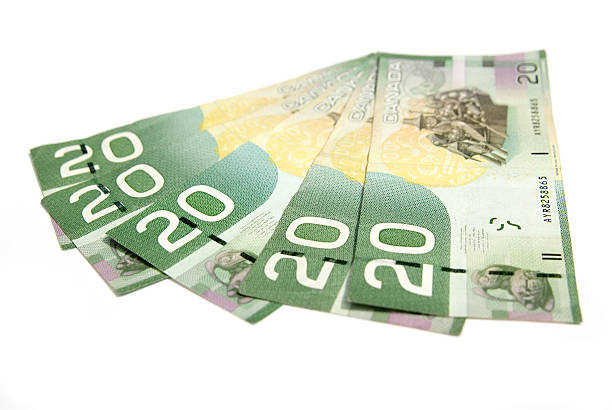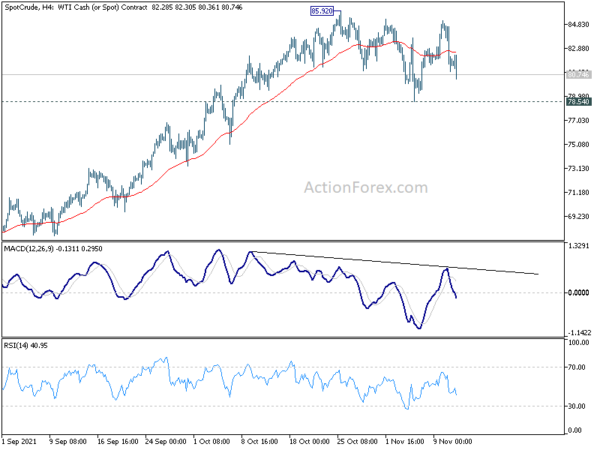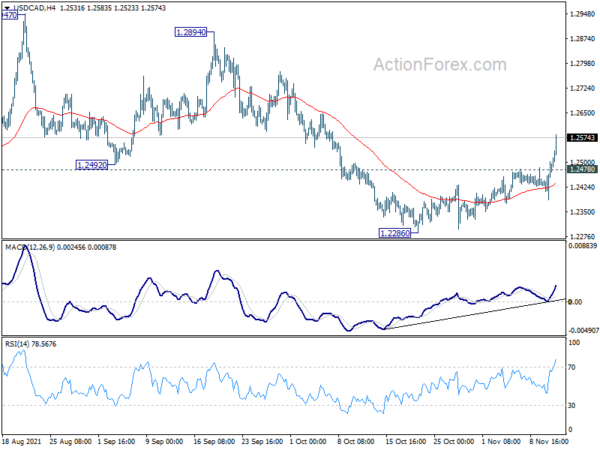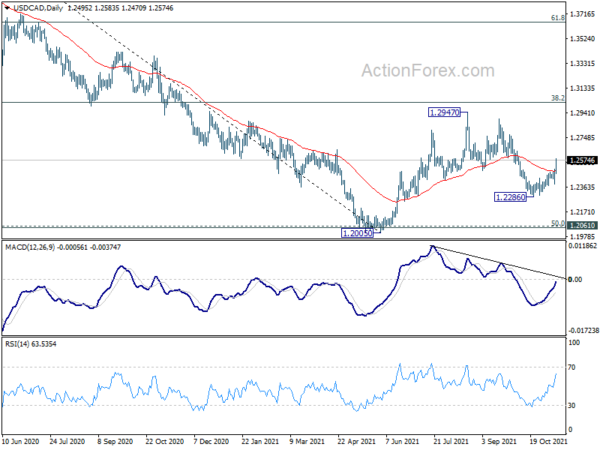Products You May Like
Selloff in Canadian Dollar gathers pace today as WTI oil price is quickly heading back towards 80 handle. Other commodity currencies are also weak, with Aussie weighed down by poor job data. On the other hand, Dollar is staying firm without clear sign of loss momentum yet. Yen is also not performing too bad, as it’s still trying to eke out more gains in crosses. Euro is mixed for now, even though EU upgrades Eurozone inflation forecasts.
Technically, WTI crude oil has started another falling leg inside the consolidation pattern from 85.92. Some downside could be seen but strong support will likely be seen around 78.54 support to bring rebound. However, sustained break of 78.54 will at least bring deeper pull back to correct the rise from 61.90. In that case, we could be selling in Canadian Dollar intensify.
In Europe, at the time of writing, FTSE is up 0.33%. DAX is up 0.10%. CAC is up 0.03%. Germany 10-year yield is up 0.0107 at -0.235. Earlier in Asia, Nikkei rose 0.59%. Hong Kong HSI rose 1.01%. China Shanghai SSE rose 1.15%. Singapore Strait Times rose 0.21%. Japan 10-year JGB yield rose 0.0105 to 0.071.
EU expect Eurozone inflation to peak at 2.4% this year
In the Autumn Economic Forecast, European Commission upgraded 2021 GDP growth projection to 5.0% (vs Spring’s forecast of 4.3%). Growth is projected to slow to 4.3% in 2022 (vs 4.4), and then 2.4% in 2023.
HICP inflation is projected to peak at 2.4% in 2021 (vs Spring’s 1.7%), then slow to 2.2% in 2022 (vs prior 1.3%) and then slow to 1.4%.
Valdis Dombrovskis, Executive Vice-President for an Economy that Works for People, said: “This is no time for complacency: we continue to face uncertainty with this virus and there are some risks to contend with. Not least, we need to address bottlenecks in supply chains, as well as surging energy prices which will affect many households and companies across Europe. We also need to closely monitor inflation and adjust our policies if needed.”
ECB bulletin: Market-based inflation indicators in line with transient but more persistent rise
In the monthly economic bulletin, ECB said the current phase of higher inflation will “last longer than originally expected”, but it’s “expected to decline in the course of next year”. The factors include sharply risen energy prices, recovering demand outpacing supply, and based effects due to end of VAT cut in Germany. It added, “the influence of all three factors is expected to ease in the course of 2022 or to fall out of the year-on-year inflation calculation”.
Meanwhile, ECB also noted that market-based indicators of longer-term inflation expects reached “new highs”. Five-year forward inflation-linked swap (ILS) rate five years ahead rose above to 2.1%, highest since August 2014. But it also noted that the increase in ILS rate was “pronounced in short and medium-term maturities”. That’s “in line with a transient but more persistent increase in near-term inflation”.
UK GDP grew 0.6% mom in Sep, 1.3% qoq in Q3
UK GDP grew 0.6% mom in September, slightly above expectation of 0.6% mom. GDP remained -0.6% below its pre-coronavirus level in February 2020. Looking at some details, services grew 0.7% mom. Production dropped -0.4% mom while manufacturing dropped -0.1% mom. Construction rose 1.3% mom.
For Q3 as a whole, GDP grew 1.3% qoq, below expectation of 1.5% qoq. It remains -2.1% below the pre-pandemic level in Q4 2019.
Manufacturing production dropped -0.1% mom, rose 2.8% yoy in September, versus expectation of 0.2% mom, 4.1% yoy. Industrial production dropped -0.4% mom, rose 2.9% yoy, versus expectation of 0.2% mom, 3.1% yoy.
Goods trade deficit widened to GBP -14.7B in September, versus expectation of GBP -14.3B.
UK NIESR expects 1.1% GDP growth in Q4, as post-Covid bounce nearing its end
NIESR said it expects UK GDP to grow by 1.1% qoq in Q4, including 0.4% mom growth in October.
Rory Macqueen Principal Economist, Macroeconomic Modelling and Forecasting said: The post-Covid bounce seems to be nearing its end, with hospitality returning to normal growth rates in September after a bumper August. Wholesale and retail activity shrank for a fifth consecutive month and gas distribution for the fourth, which may suggest supply constraints or the unwinding of unusually high demand earlier in the year.
“Overall growth is likely to slow further in the fourth quarter but will benefit if public confidence in keeping Covid-19 under control has enabled a return to growth in consumer-facing services sectors.”
Australia employment dropped -46.3k, unemployment rate jumped to 5.2%
Australia employment decreased -46.3k in October, much worse than expectation of 50k rise. At 12.84m, employment level was back below pre-pandemic peak. Full time jobs dropped -40.4k while part-time jobs dropped -5.9k.
Unemployment rate jumped sharply from 4.6% to 5.2%, well above expectation of 4.7%. But participation rate also rose slightly from 64.5% to 64.7%. Monthly hours worked dropped -1m hours.
Bjorn Jarvis, head of labour statistics at the ABS: “The increases in unemployment show that people were preparing to get back to work, and increasingly available and actively looking for work – particularly in New South Wales, Victoria and the Australian Capital Territory. This follows what we have seen towards the end of other major lockdowns, including the one in Victoria late last year.”
“It may seem counterintuitive for unemployment to rise as conditions are about to improve. However, this shows how unusual lockdowns are, compared with other economic shocks, in how they limit being able to work and look for work.”
Japan PPI surged to 8% yoy in Oct, highest since 1981
Japan corporate goods price index rose 8.0% yoy in October, up from September’s 6.4% yoy, well above expectation of 6.9% yoy. That’s also the highest level since January 1981.
Looking at some details, lumber & wood surged 57.0% yoy. Petroleum and cola rose 44.5% yoy. Iron and steel rose 21.8%. Nonferrous metals rose 31.4% yoy. Export price rose 13.7% yoy while import price rose 38.0% yoy.
USD/CAD Mid-Day Outlook
Daily Pivots: (S1) 1.2422; (P) 1.2463; (R1) 1.2539; More…
USD/CAD’s rally from 1.2286 accelerates to as high as 1.2583 so far today. As noted before, fall from 1.2947 might have completed with three waves down to 1.2286. Further rally would be seen back to retest 1.2894/2947 resistance zone. On the downside, however, break of 1.2478 minor support will mix up near term outlook and turn intraday bias neutral again first.
In the bigger picture, medium term outlook is neutral for now. The pair draw support from 1.2061 cluster and rebounded. Yet, upside was limited below 38.2% retracement of 1.4667 to 1.2005 at 1.3022. On the upside, firm break of 1.3022 should affirm the case of medium term bullish reversal. However, break of 1.2286 will turn focus back to 1.2005 low again.
Economic Indicators Update
| GMT | Ccy | Events | Actual | Forecast | Previous | Revised |
|---|---|---|---|---|---|---|
| 23:50 | JPY | PPI Y/Y Oct | 8.00% | 6.90% | 6.30% | 6.40% |
| 0:01 | GBP | RICS Housing Price Balance Oct | 70% | 68% | 68% | 69% |
| 0:30 | AUD | Employment Change Oct | -46.3K | 50K | -138K | -141.1K |
| 0:30 | AUD | Unemployment Rate Oct | 5.20% | 4.70% | 4.60% | |
| 7:00 | GBP | GDP Q/Q Q3 P | 1.30% | 1.50% | 5.50% | |
| 7:00 | GBP | GDP M/M Sep | 0.60% | 0.50% | 0.40% | 0.20% |
| 7:00 | GBP | Index of Services 3M/3M Sep | 1.60% | 1.90% | 3.70% | 3.50% |
| 7:00 | GBP | Manufacturing Production M/M Sep | -0.10% | 0.20% | 0.50% | 0.30% |
| 7:00 | GBP | Manufacturing Production Y/Y Sep | 2.80% | 4.10% | 4.10% | |
| 7:00 | GBP | Industrial Production M/M Sep | -0.40% | 0.20% | 0.80% | 1.00% |
| 7:00 | GBP | Industrial Production Y/Y Sep | 2.90% | 3.10% | 3.70% | |
| 7:00 | GBP | Goods Trade Balance (GBP) Sep | -14.7B | -14.3B | -14.9B | -13.7B |
| 9:00 | EUR | ECB Monthly Bulletin | ||||
| 12:00 | GBP | NIESR GDP Estimate Oct | 1.50% |




